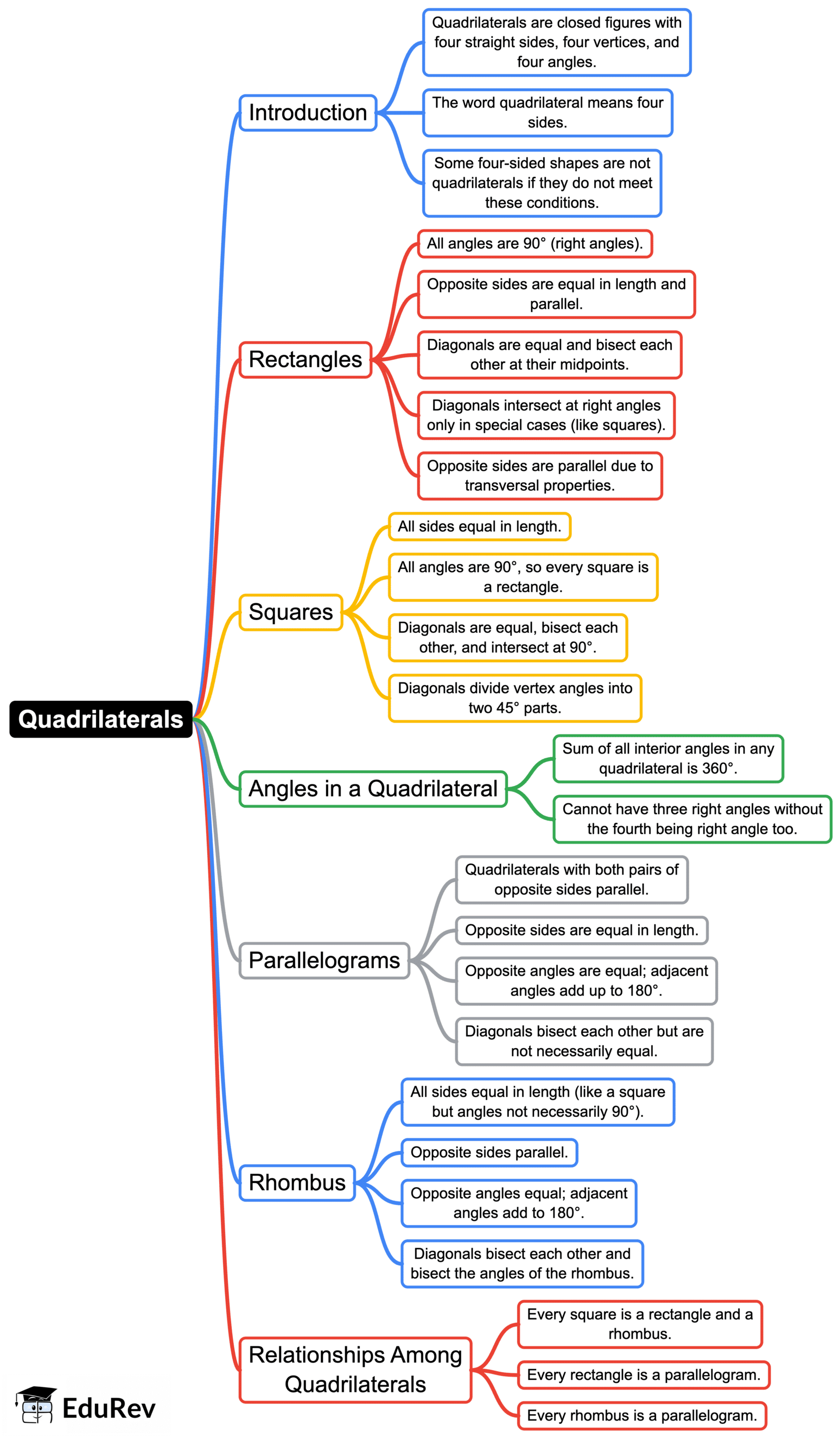Class 8 Exam > Class 8 Notes > Mathematics Class 8- New NCERT (Ganita Prakash) > Mind Map: Quadrilaterals
Mind Map: Quadrilaterals | Mathematics Class 8- New NCERT (Ganita Prakash) PDF Download

The document Mind Map: Quadrilaterals | Mathematics Class 8- New NCERT (Ganita Prakash) is a part of the Class 8 Course Mathematics Class 8- New NCERT (Ganita Prakash).
All you need of Class 8 at this link: Class 8
|
22 videos|133 docs|11 tests
|
FAQs on Mind Map: Quadrilaterals - Mathematics Class 8- New NCERT (Ganita Prakash)
| 1. What are the different types of quadrilaterals and how are they categorized? |  |
Ans. Quadrilaterals are categorized based on their properties such as sides and angles. The main types include:
1. Square: All sides are equal, and all angles are 90 degrees.
2. Rectangle: Opposite sides are equal, and all angles are 90 degrees.
3. Rhombus: All sides are equal, but angles are not necessarily 90 degrees.
4. Parallelogram: Opposite sides are equal and parallel, and opposite angles are equal.
5. Trapezium (or trapezoid): Only one pair of opposite sides is parallel.
6. Kite: Two pairs of adjacent sides are equal.
| 2. What is the significance of the sum of the interior angles of a quadrilateral? |  |
Ans. The sum of the interior angles of a quadrilateral is always 360 degrees. This property is significant because it helps in solving various geometric problems involving quadrilaterals, such as finding unknown angles when some angles are given. This sum is derived from the fact that a quadrilateral can be divided into two triangles, each having a sum of angles equal to 180 degrees.
| 3. How can we determine the area of different types of quadrilaterals? |  |
Ans. The area of quadrilaterals can be calculated using different formulas based on their type:
1. Square: Area = side × side (s²).
2. Rectangle: Area = length × width (l × w).
3. Parallelogram: Area = base × height (b × h).
4. Trapezium: Area = (1/2) × (sum of parallel sides) × height.
5. Rhombus: Area = (diagonal₁ × diagonal₂) / 2.
Understanding these formulas is essential for solving problems related to quadrilaterals in geometry.
| 4. What are the properties of a parallelogram that distinguish it from other quadrilaterals? |  |
Ans. Parallelograms have several unique properties that set them apart from other quadrilaterals:
1. Opposite sides are equal in length and parallel.
2. Opposite angles are equal.
3. The diagonals bisect each other at their midpoints.
4. The sum of the interior angles is 360 degrees.
These properties are critical for identifying and working with parallelograms in various geometric contexts.
| 5. How do the properties of a kite differ from those of other quadrilaterals? |  |
Ans. Kites have distinct properties that differentiate them from other quadrilaterals:
1. Two pairs of adjacent sides are equal in length.
2. One pair of opposite angles (the angles between the unequal sides) are equal.
3. The diagonals intersect at right angles, and one diagonal bisects the other.
These unique characteristics are important for recognizing kites in geometric problems and understanding their behavior in various scenarios.
Related Searches
















